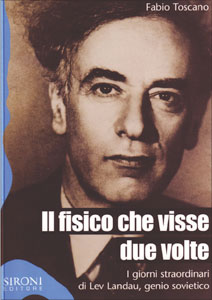By Fabio Toscano, Sironi Editore. Paperback ISBN 9788851800963, €18.
Il fisico che visse due volte – the physicist who lived twice – is Lev Davidovich Landau, the iconoclastic physicist and 1962 Nobel Laureate. One of the greatest theorists of the Soviet Union, he made significant contributions to almost all fields in physics, from superfluidity to the properties of ferromagnetic bodies, from the absorption of sound in solids to the theory of phase transitions. This biography by Fabio Toscano, an Italian theorist with a broad experience in communicating science, nicely guides the reader through all aspects of this rich scientific production, never neglecting to present it primarily as a human adventure.

The main focus, as I expected, is on Landau’s attitude to physicists and people in general, and thanks to this book I discovered his rather peculiar personality. Unpleasant to most of the people with whom he interacted, he was loved by some of his colleagues and friends who had a great admiration for his broad knowledge and his courage always to say what he thought, regardless of constraints from politics, society or academic authority. His straight-talking attitude caused serious problems to both his career and his private life (he spent one year in prison) at a time when the Soviet Union was under Stalin’s dictatorship.
In addition to his written contributions and original articles, one of Landau’s main legacies for Russian science is the “Landau school”. To be admitted to the school, students had to pass a comprehensive exam, the “Theoretical Minimum”, designed personally by Landau. As Toscano explains, Landau kept personal contact with all his students until he died in 1968, six years after a car accident that brought him close to death. In the accident “not even the eggs Vera [the driver’s wife] had in her hands broke”, but Landau’s brain suffered from serious injuries that left him in a coma for three months. He never fully recovered, and was afterwards much less creative.
This book certainly shows Landau with all his humanity, even emphasizing some of the scientific traps into which he fell. However, the details about Russia’s history and social situation that the author likes so much sometimes make the reading hard and the focus too distant. When “stuck” in such pages, I was eager to come back to Landau’s real life in Moscow or Baku or Karkhov and follow him, for example in meeting Bohr and quantum mechanics. Having studied some of the volumes of the Course of Theoretical Physics that Landau wrote with Evgeny Lifshitz and other colleagues, I appreciated this biography. Toscano’s account is very accurate – even scientific – and describes well Landau’s personality, the raison-d’être of the book.








